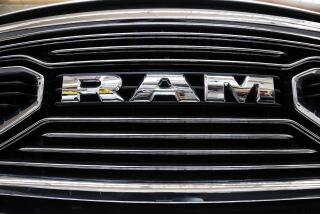Bruising Tests Await Consumer Reports in Court
- Share via
Consumer Reports, the magazine millions turn to before shopping for everything from cosmetics to cars, is under fire by two auto makers in lawsuits that constitute the most serious attack ever on the 63-year-old publication.
Judges in Southern California could decide as early as this week to send the federal cases to trial, and some legal experts say the suits could have a dangerously chilling effect on the media’s willingness to publish negative product reviews.
The product-disparagement suits, by Japanese auto makers Suzuki Motors Corp. and Isuzu Motors Ltd., claim the magazine rigged driving tests for its 1988 review of Suzuki’s Samurai and its 1996 review of the Isuzu Trooper and its twin, the Isuzu-built Acura SLX.
Consumer Reports called the sport-utility vehicles “not acceptable”--its worst rating--and urged consumers not to buy them because they exhibited a dangerous propensity to roll over under emergency steering conditions. The magazine’s publisher, Consumers Union, stands by its reviews and maintains that its right to criticize is protected by law.
But the auto makers’ suits raise substantial questions about the magazine’s methods--questions legal specialists say should be compelling enough to send the cases to trial despite Consumers Union’s pending bids in U.S. District Court in Los Angeles and Santa Ana to have them dismissed.
Two key questions:
* Why did Consumer Reports devise a tough new accident-avoidance handling course for SUVs and other light trucks as part of its Samurai test only after failing in 46 tries--on the course it had used since 1972--to get the vehicle to tip up during a highway-speed directional change?
* Is the avoidance test objective and scientific, as the magazine maintains, or is it a subjective test heavily influenced by the driving style of the testers, as claimed by the National Highway Traffic Safety Administration, or NHTSA, and the agency’s counterparts in Britain and Switzerland.
The two auto companies are seeking more than $50 million in combined damages and say the negative reviews have cost them more than $500 million in sales.
The consumers group may be fighting for its life. Some observers believe that the huge legal bills being run up could affect Consumers Union’s ability to keep the estimated $30 million in liability coverage it needs to conduct its work.
Consumers Union President Rhoda Karpatkin vehemently denies that the case is causing financial difficulty.
But others do worry.
“If Consumers Union, which has no agenda, is silenced, there’s got to be not only an effect on it but a trickle-down effect on much less hard-hitting reports by the mainstream media,” said Jonathan Kotler, a USC journalism professor and media law specialist.
The $35 million spent thus far on cases that haven’t gone to trial “seems to be outrageously expensive and indicates there is intimidation at work,” said UC Berkeley law professor Robert Post, a libel and slander specialist.
“The value of a lawsuit isn’t always about the law. Sometimes it changes the ballgame because it shows that certain industries are willing to use their financial muscle to bully the press, especially the [financially] weaker members, into feeling it is not worth their while to criticize,” he said.
Consumers Union officials scoff at the auto makers’ claims that there was a hidden agenda at work in the negative reviews--that the magazine was attempting to generate controversy to bolster its circulation and fund-raising abilities.
In fact, Consumers Union general counsel Michael Pollet suggests that the companies have an agenda of their own: General Motors Corp., the world’s biggest auto maker, owns 49.9% of Isuzu and 9.9% of Suzuki and has an economic interest in seeing them prevail.
There are myriad legal issues raised in the suits, but the heart of both cases is the attack on Consumers Union’s honesty.
So far, according to insiders in the complex case, Suzuki and Isuzu collectively have spent more than $25 million on legal fees, expert witnesses, private investigators and technical studies. These insiders say Consumers Union has spent $10 million or more trying to kill the suits without a trial, arguing that Suzuki and Isuzu are attacking a fundamental right of the media in this country: the right to criticize.
But Suzuki attorney George Ball says the company has practiced restraint, not intimidation, waiting eight years to sue even though the initial review almost killed the then-popular Samurai, whose sales plummeted by 73% the year after the article ran. It wasn’t until Consumer Reports repeated its charges against the Samurai in a 60th-anniversary edition in 1996 that Suzuki went to court.
And Isuzu waited almost a year to file its suit and says it did so only because Consumer Reports began republishing its condemnation of the Trooper after NHTSA issued its third report since 1978 criticizing the magazine’s claims that its accident-avoidance test is a scientific one with accurate, repeatable, real-world results.
The Samurai was targeted, Ball contends, because it was then one of the most popular small SUVs in the U.S. and, despite generally positive reviews from automotive critics, had already drawn some flak--principally from NBC News, which broadcast a three-part series in early 1988 questioning the Samurai’s stability.
Suzuki contends that Consumers Union, facing the need to raise more than $9 million to pay for its new headquarters complex in Yonkers, N.Y., decided to blast the Samurai and build a fund-raising campaign around the claim that it had taken a courageous stand on behalf of consumers.
When the magazine’s testers couldn’t make the Samurai misbehave in the regular obstacle-avoidance course that had been in use since 1972, Suzuki argues, they created a new test guaranteed to cause a roll-inducing tip-up, then concealed from readers the fact that a skilled driver could make almost any SUV tip up in the new “short course” handling test.
Much of Suzuki’s case is built on volumes of technical analyses and expert witnesses’ statements bolstering its claims about the test. The so-called double lane change requires the driver in the course of a few seconds to make four changes of direction at speeds of 35 to 45 mph without using the vehicle’s brakes, and while staying within two 12-foot-wide lanes.
Isuzu’s suit claims that when Consumer Reports condemned the Trooper in 1996, there was plenty of evidence that reliable entities such as NHTSA considered the short-course test a flawed one whose results could be affected by a driver’s skill. The magazine knew or should have known about the criticisms and should have altered or halted the test, the suit argues. By using it, unchanged, to rate the Trooper “not acceptable,” Consumers Union showed a malicious disregard for the truth, the suit says.
And the motive? Consumer Reports used the Trooper review, Isuzu trial attorney Andrew White says in an echo of Suzuki’s suit, to generate publicity at a time when it needed to bolster sagging circulation and combat NHTSA criticism.
Consumers Union officials say the revised driving course was designed specifically to test the stability of SUVs and other light trucks under more extreme conditions than the long course, or passenger car test, allows. Since 1988, the short course has been the standard for light trucks. Of the 80 vehicles tested on it, only the Samurai and the Trooper/SLX have failed, although three other SUVs have received low ratings because one or more wheels lifted off the ground.
The magazine’s lawyers also maintain that offhand, seemingly prejudicial comments made during intense testing sessions have been taken out of context by the car companies; that there is no crime in disagreeing with the government over the validity of a test; and that the auto makers are trying to bludgeon Consumer Reports into silence with crippling legal bills.
The magazine’s stature is such that only nine other companies have ever dared sue it and risk a consumer backlash. Consumers Union won all nine cases.
In the SUV suits, Consumers Union is relying on affidavits from test drivers, engineers and others including technical director R. David Pittle and Richard Knoll, the retired test track director who presided over the Samurai and Trooper tests, to prove that the short-course procedure is a valid test for praising or condemning a vehicle.
The auto companies have brought big legal guns to the table--especially Suzuki, which has been hit with scores of Samurai rollover injury claims since the Consumer Reports review. Suzuki’s lead trial attorney, Newport Beach litigator Ball, is a former top GM lawyer.
For now, both the Isuzu and Suzuki suits are idling as federal judges craft decisions on Consumers Union’s requests for judgments in its favor without a trial. The publisher maintains that even if it made mistakes in its reviews, the auto makers have not shown evidence of the malicious intent needed to prove their claims.
The Isuzu case is scheduled to go to trial Nov. 30 in U.S. District Court in Los Angeles if Judge Richard A. Paez rejects Consumers Union’s summary judgment motion. Trial of the Suzuki case, filed in U.S. District Court in Santa Ana, was postponed indefinitely this summer by Judge Alicemarie Stotler pending her decision on a similar motion.
In any trial--win or lose--Consumer Reports is likely to emerge with a bit of tarnish on its shining armor. The car companies are throwing too much muck for some of it not to stick.
That bothers Karpatkin, Consumers Union’s president, who cannot imagine losing but sees damage spreading far beyond her organization if the unimaginable happens:
“The issue is whether they can silence this major independent consumer product testing organization. Because if they do, there is nobody else like us out there to take manufacturers’ products, purchase them anonymously and tell people honestly what we found.”
*
Times staff writer Myron Levin contributed to this report.






